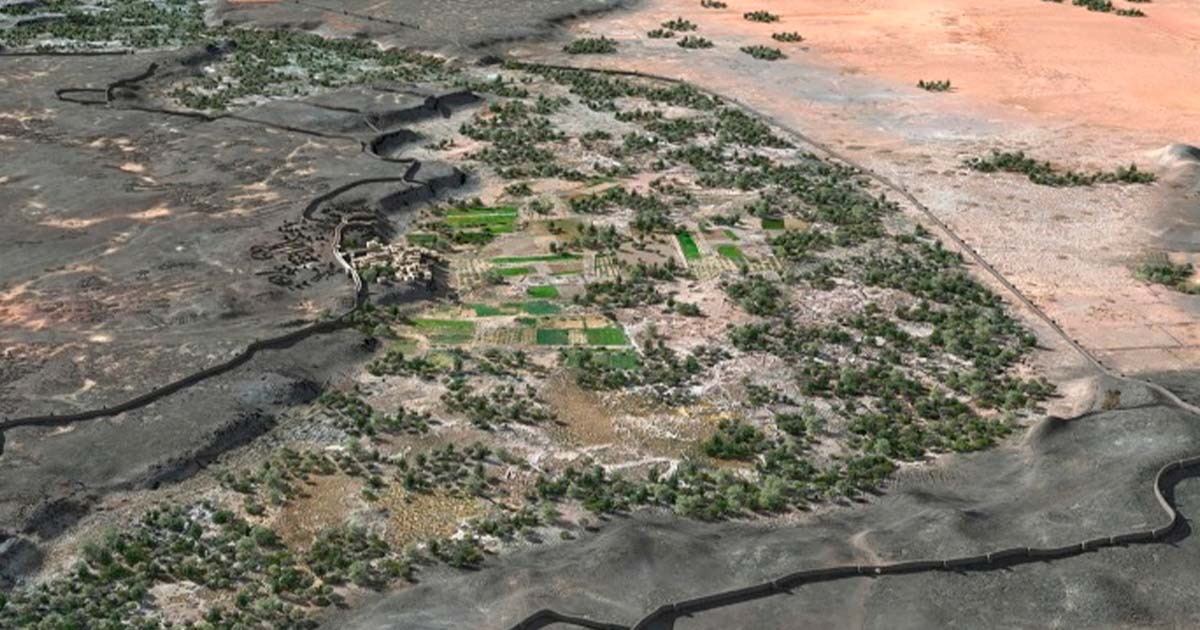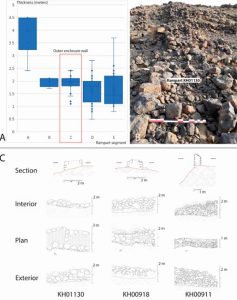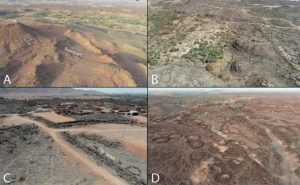Large Oasis Fortification Found in North Arabia That Is 4,000 Years Old

Researchers have found a 4,000-year-old fortification defending an oasis in the North Arabian Desert, at the ancient Khaybar Oasis. It is officially one of the longest known structures – 14.5 kilometers (9 mi), dated to the 4th and 3rd millennia BC. What is left of the rampart’s remains have been dated to between 2250 and 1950 BC, at a time when sedentary populations inhabited the area and oases were common.
New Study Reveals Ancient Arabian Peninsula Funerary Avenues Network
Footprints Reveal Passage of Early Humans From Africa Through Arabia
Human Habitation in Northwest Arabia and Nomad Pastoralist Groups
Archaeologists from the CNRS and the Royal Commission for AlUla (RCU) have stated that this discovery, alongside the Tayma Oasis, marks one of the two largest walled oases in Saudi Arabia. They have published these finds in a new study in the Journal of Archaeological Science: Reports, which has shed new light into human habitation in north-western Arabia during the pre-Islamic era.
Utilizing a combination of field surveys, remote sensing data, and architectural studies, the research team approximated the original dimensions of the fortifications, revealing a structure stretching 14.5 kilometers (9 mi) in length, 1.70 to 2.40 meters (5.5-8.7 ft) in thickness, and standing at approximately 5 meters (16.5 ft) in height.

Study of the masonry of the ramparts. A. Variability of the range of thickness of each rampart group; B. View of the currently preserved masonry of the outer enclosure wall (rampart KH01130) facing north; C. Example of architectural study conducted on outer enclosure wall segments showing inner masonry variability. (© Khaybar LDAP, G. Charloux. T. Terrasse/ Journal of Archaeological Science)
With over 41% of its original length, or 5.9 km [3.66 mi], and 74 bastions still in some state of preservation, the massive edifice enclosed a sedentary territory of nearly 1,100 hectares (718.15 ac). The study confirms that the Khaybar Oasis is a part of a network of walled oases in the region, according to a press release by the Center for Scientific Research, France (CNRS).

Aerial views of the dry-stone basement of the outer rampart: A. Segment KH00911 facing south; B. Segment KH01130 facing north; C. Segments KH00904-KH00905 and KH00906 facing south; D. segment KH00922, (© Khaybar LDAP, G. Charloux/© Khaybar LDAP, M. Bussy & G. Charloux/ Journal of Archaeological Science)
The researchers reckon it was nomad pastoralists who settled here:
“Mobile pastoralist groups would have settled in the Khaybar Oasis in a strategic area with a good water supply, ostentatiously demarcating their living and cultural space, in keeping with the principles of plot demarcation for agriculture and grazing. While this indigenous development possibly looked to defend areas of agricultural and water resources from outside… the outer rampart certainly indicates a social and territorial marker,” they write.
Bahla Fort: Oman’s Incredible Desert Oasis
New Site is Found in an “Archaeological Oasis” of the Egyptian Eastern Desert
What’s in an Oasis? Flourishing Amidst the Aridity
An oasis, a small but fertile expanse of greenery in the midst of the desert, thrives with life thanks to freshwater sources like subterranean rivers and elevated water tables. They generally occur in deserts or semi-arid regions, and can transform into flourishing sanctuaries, providing a vibrant habitat for diverse plant and animal species.
Within desert regions, oases have, and continue to play, pivotal roles as essential havens and central hubs for human settlement, agriculture, and trade. Functioning as dependable water sources in arid and challenging environments, these oases naturally became focal points for communities to thrive. The implementation of human-engineered aquifers and channels have historically contributed to the irrigation of these regions, fostering conditions conducive for sustained human settlements.
A number of walled oases, dating as far back as the Bronze Age (3300–1200 BC), have been unearthed in north-western Arabia. During this era, fortified settlements, akin to the monumental European “megaforts,” emerged.
The arid expanses of the Arabian deserts host some of the world’s earliest fortifications, exemplified by the Citadel of Aleppo in Syria, the largest identifiable stone fortress globally, with a history of habitation spanning 4,500 years. Just last year, the discovery of the world’s oldest fortress occurred, revealing a structure from Stone Age Siberia that dates back 8,000 years, reports Cosmos Magazine.
Through this project, researchers have unearthed evidence suggesting that the initial occupations of the oasis date back much earlier, spanning the Paleolithic and Neolithic periods. Discoveries include various funerary structures, desert kites (dry stone wall constructions indigenous to the region), as well as a multitude of inscriptions and rock art representing diverse periods and traditions.
These findings illuminate a rich and extensive history of civilizations in Arabia that remains largely undiscovered. The role and significance of oasis fortifications within the broader context of the Bronze Age remain unclear.
“The Khaybar oasis is a hotbed of local history in northwest Saudi Arabia. It has been preserved for millennia, and its human occupation seems to have been uninterrupted from earliest prehistoric times to the present day,” reads a release from Khaybar Longue Durée Project, through which the research was carried out.